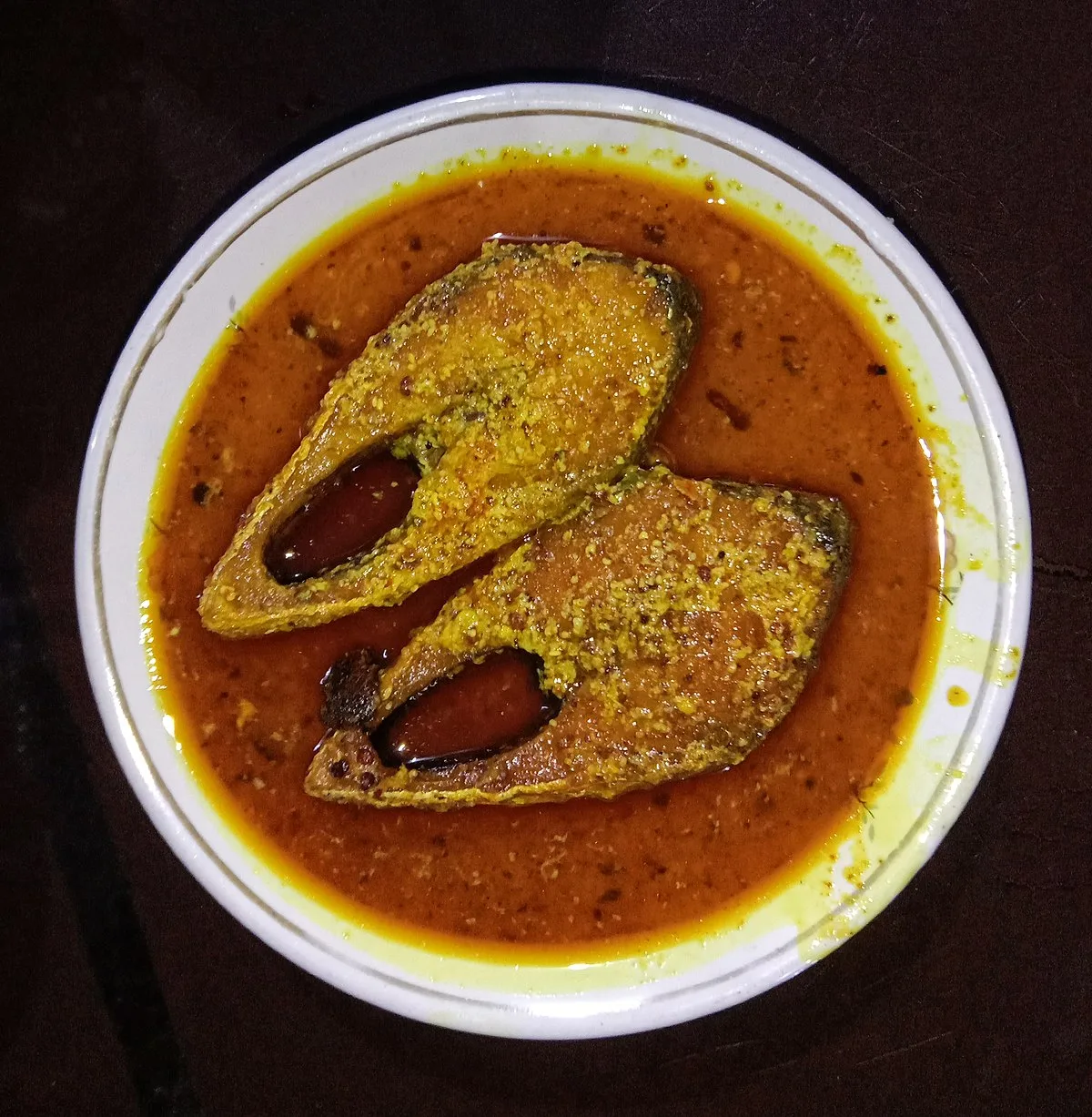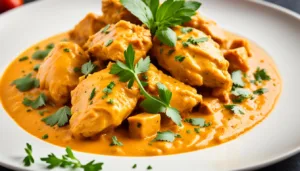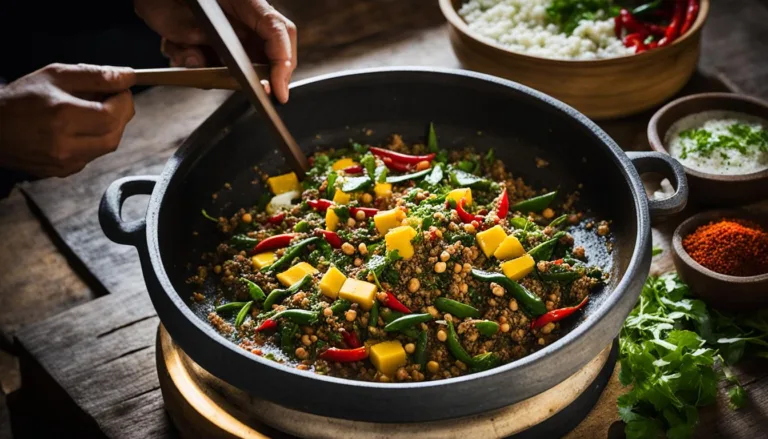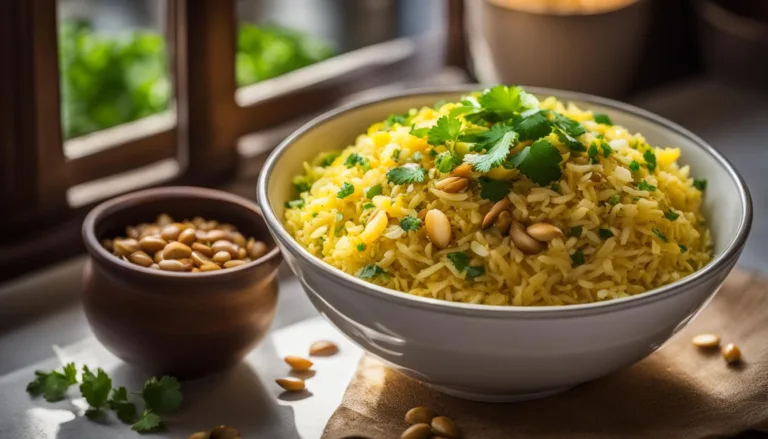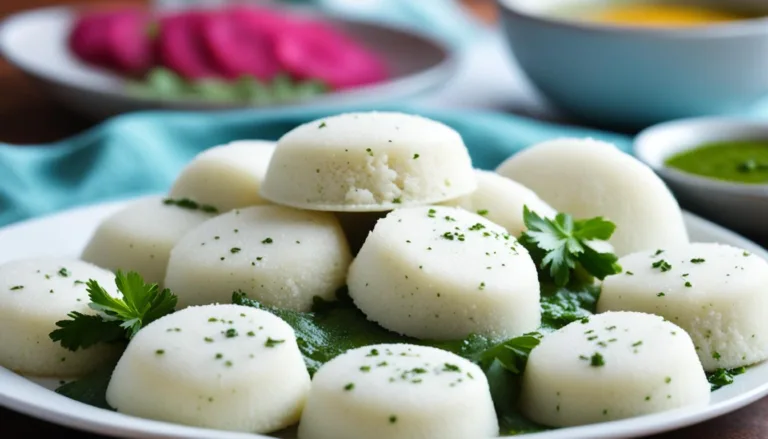Welcome to our article on an easy Hilsa recipe for a perfect dinner treat! Whether you’re hosting a dinner party or simply want to enjoy a special meal at home, this recipe is sure to impress. The Hilsa, also known as the “king of fish,” is a highly prized and sought-after delicacy in Bengali cuisine. With its rich flavors and delicate texture, it’s no wonder why Hilsa holds a special place in the hearts of seafood lovers.
In this section, we will provide you with a step-by-step guide to create a delicious Hilsa dish that will tantalize your taste buds. So, let’s get ready to indulge in the flavors of Hilsa and embark on a delightful culinary adventure!
Table of Contents
Key Takeaways:
- Discover an easy and delicious Hilsa recipe for a perfect dinner treat
- Learn about the rich flavors and delicate texture of the Hilsa fish
- Understand the cultural significance of Hilsa in Bengali cuisine
- Explore marination techniques and essential ingredients for enhancing the flavor of Hilsa
- Get step-by-step instructions to master the traditional Bengali dish, Bhapa Ilish
Introduction to Hilsa: The King of Fish
Hilsa, also known as the “king of fish,” is a highly prized and sought-after fish in Bengali cuisine. Known for its rich flavor and delicate texture, hilsa holds a special place in the hearts of seafood lovers.
In this section, we will delve into the various aspects of hilsa, including its taste, texture, and cultural significance. Let’s explore what makes hilsa the king of fish.
The Historical Significance of Hilsa in Bengali Cuisine
Hilsa, a beloved fish in Bengali cuisine, holds immense historical significance and is deeply intertwined with various cultural traditions and festivals. Understanding the deep-rooted connection between hilsa and Bengali culture enhances our appreciation for this delectable delicacy.
Connection to Biswakarma Puja and Festivities
One such festival where hilsa takes center stage is Biswakarma Puja, a celebration dedicated to the revered god of architecture and engineering. During this auspicious occasion, hilsa is considered a symbol of prosperity and is an integral part of the festive feasts. Its inclusion in the menu is believed to bring luck and good fortune to the devotees, making it a significant culinary offering.
Cultural Traditions: Arandhan and No Cooking Day
Alongside festivals, hilsa also plays a prominent role in cultural traditions such as Arandhan and No Cooking Day. Arandhan, a unique cooking tradition, sees hilsa prepared with minimal spices and cooked in a clay oven, resulting in a distinct flavor that showcases the natural taste of the fish. On No Cooking Day, hilsa is not cooked at all. Instead, it is marinated with spices and served raw, allowing the delicate flavors to unfold.
These traditions highlight the versatility of hilsa in Bengali cuisine and showcase the reverence for this fish in local customs and practices.
Tagore’s Influence: Celebrating Craftsmanship and Industry
Bengali culture has been greatly influenced by the renowned poet and philosopher, Rabindranath Tagore, and his appreciation for craftsmanship and industry. Tagore’s love for hilsa is well documented, and he often used hilsa as a metaphor for celebrating the artistry and skill of craftsmen.
Through Tagore’s influence, hilsa has become more than just a fish. It has become a symbol of the beauty and creativity that permeates Bengali culture, elevating its historical significance to new heights.
As we explore the historical roots of hilsa in Bengali cuisine, we gain a deeper understanding of the cultural traditions, festivals, and artistic influences that have made this fish an integral part of the region’s culinary heritage.

Celebrating Hilsa: Ingredients and Marination Techniques
To truly celebrate hilsa, it is essential to understand the key ingredients and marination techniques that enhance its flavor. In this section, we will explore the essential ingredients used in hilsa recipes and discover the marination techniques that bring out the best in this flavorful fish. From spices to herbs, we will cover everything you need to know to create a memorable hilsa dish.
Mastering the Bhapa Ilish: A Step-by-Step Guide
Bhapa Ilish is a popular and traditional Bengali preparation of hilsa that is known for its succulent flavors. If you want to recreate this delicious dish at home, we’ve got you covered with our step-by-step guide.
Preparing Your Ingredients
Before you start cooking, it’s important to gather all the necessary ingredients for Bhapa Ilish. Here’s a list of what you’ll need:
- Fresh hilsa fish
- Mustard paste
- Poppy seed paste
- Green chili paste
- Turmeric powder
- Salt
- Mustard oil
- Banana leaves or aluminum foil
Make sure to clean and prepare the hilsa fish properly before proceeding with the recipe.
The Art of Steaming Hilsa in the Microwave
If you prefer a quicker method, you can steam the hilsa fish using a microwave. Follow these steps:
- Place the cleaned hilsa fish in a microwave-safe dish.
- In a separate bowl, mix together mustard paste, poppy seed paste, green chili paste, turmeric powder, salt, and mustard oil.
- Spread this mixture evenly over the hilsa fish, ensuring that it is well-coated.
- Cover the dish with a microwave-safe lid or use microwave-safe plastic wrap to create a seal.
- Place the dish in the microwave and cook on high for about 10-12 minutes, or until the fish is cooked through and tender.
- Once cooked, remove from the microwave and let it rest for a few minutes before serving.
Traditional Stovetop Method for Bhapa Ilish
If you prefer a more traditional approach, you can steam the hilsa fish on the stovetop. Here’s how:
- Wrap the cleaned hilsa fish in banana leaves or aluminum foil, ensuring that it is well-covered.
- In a steamer or a large pot, add water and bring it to a boil.
- Place the wrapped hilsa fish in the steamer or pot and cover it with a lid.
- Steam the fish for approximately 15-20 minutes, or until it is cooked through and easily flakes with a fork.
- Once cooked, carefully remove the fish from the steamer and unwrap it.
- Serve the Bhapa Ilish hot with steamed rice or your choice of accompaniments.
With these step-by-step instructions, you’ll be able to master the art of Bhapa Ilish and enjoy the rich flavors of this traditional Bengali delicacy.
Exploring Different Hilsa Dishes: A Culinary Adventure
Hilsa, the versatile fish with its rich flavors and delicate texture, offers a world of culinary possibilities. In this section, we invite you to embark on a culinary adventure as we explore a variety of hilsa dishes. From traditional curries to innovative preparations, there’s something to tantalize every taste bud.
1. Hilsa Biriyani: Indulge in the exquisite flavors of Hilsa Biriyani, where fragrant basmati rice and succulent hilsa come together in a perfect harmony of spices.
2. Hilsa Shorshe: Experience the tangy and zesty flavors of Hilsa Shorshe, a traditional Bengali dish where hilsa is marinated in a mustard sauce and steamed to perfection.
3. Hilsa Paturi: Delight in the smoky and aromatic notes of Hilsa Paturi, a dish where hilsa is marinated in a paste of mustard seeds, green chilies, and coconut, wrapped in banana leaves, and grilled to perfection.
4. Hilsa Jhol: Warm your soul with the comforting flavors of Hilsa Jhol, a light curry that combines hilsa with a delicate blend of spices, tomatoes, and green chilies.
5. Hilsa Korma: Indulge in the creamy and rich flavors of Hilsa Korma, where hilsa is cooked in a velvety sauce made with cashews, yogurt, and aromatic spices.
6. Hilsa Bhaja: Crisp up your taste buds with the delightful flavors of Hilsa Bhaja, where hilsa is marinated with spices, coated in a light batter, and deep-fried to perfection.
“Hilsa dishes offer a delightful blend of flavors, showcasing the versatility of this prized fish. Whether you prefer traditional recipes or want to venture into more creative preparations, exploring hilsa dishes is a true culinary adventure.”
To get you even more excited about the diverse hilsa dishes, take a look at this mouthwatering image of a sumptuous Hilsa Biriyani:
How to Source Fresh Hilsa: Tips and Tricks
Sourcing fresh hilsa is crucial to ensure the best flavor and quality in your hilsa dishes. Here, we provide valuable tips and tricks to help you source fresh hilsa for your culinary adventures.
Identifying Freshness in Hilsa Fish
To ensure you’re getting the freshest hilsa, it’s important to know how to identify freshness in the fish. Look for the following signs:
- Appearance: Fresh hilsa should have bright and clear eyes, shiny and metallic-looking scales, and a firm and elastic texture.
- Smell: A fresh hilsa should have a mild and pleasant aroma. Avoid fish with a strong, fishy smell.
- Gills: The gills of a fresh hilsa should be bright red or pink in color. Avoid fish with dull or discolored gills.
By carefully examining these features, you’ll be able to identify fresh hilsa and ensure a delicious and enjoyable culinary experience.
Best Times and Places to Buy Hilsa
Knowing the best times and places to buy hilsa can make a significant difference in the quality of the fish. Consider the following factors:
- Season: Hilsa is typically available during the monsoon season in Bangladesh, which falls between June and September. This is when hilsa is most abundant and of the highest quality.
- Local Fish Markets: Visit your local fish markets early in the morning to get the freshest catch of the day. Engage with trusted fishmongers who have a reputation for selling fresh hilsa.
- Fishing Communities: Connect with fishing communities in coastal regions who have direct access to freshly caught hilsa. This ensures you’re getting the fish straight from the source.
By considering these factors and planning your hilsa purchases accordingly, you’ll have access to the freshest hilsa and elevate your culinary creations.

Adapting Hilsa Recipes for American Kitchens
When preparing hilsa recipes in American kitchens, it’s important to make some adjustments to suit local ingredients and palates. In this section, we will provide insights into how you can adapt hilsa recipes to cater to American tastes. We will discuss the art of substituting ingredients and adjusting spices and flavors to ensure that your hilsa dishes are a perfect fit for American palates.
Substituting Ingredients
One of the key aspects of adapting hilsa recipes for American kitchens is substituting ingredients that may not be readily available. While hilsa is traditionally cooked with specific spices and herbs, you can experiment with local alternatives to achieve a similar flavor profile. For example, if you’re unable to find a specific spice, consider using a similar spice that complements the dish. Be open to trying different combinations and flavors to create a unique twist on the traditional hilsa recipes.
Adjusting Spices and Flavors to Suit Palates
American palates vary in their preferences for spices and levels of spiciness. To adapt hilsa recipes for American kitchens, it’s crucial to adjust the spices and flavors accordingly. You may need to reduce the spice levels or add additional spices to enhance the flavor profile. Consider the preferences of your intended audience and adjust the spices and flavors to suit their taste buds. It’s all about striking the right balance and creating a dish that will be enjoyed by everyone.
With a little creativity and flexibility, you can successfully adapt hilsa recipes for American kitchens, allowing everyone to experience the flavors of this exquisite fish. Keep in mind that the goal is to create a dish that not only pays homage to the traditional hilsa recipes but also appeals to the diverse American palate.
So let’s dive in and explore the art of adapting hilsa recipes for American kitchens!
The Health Benefits of Hilsa: More Than Just Delicious
Hilsa not only delights the taste buds but also offers numerous health benefits. This delectable fish is a powerhouse of nutrients, including omega-3 fatty acids, vitamins, and minerals that contribute to your overall well-being.
Omega-3 fatty acids are essential for brain health, reducing inflammation, and promoting cardiovascular health. Hilsa is an excellent source of these beneficial fats, making it an ideal addition to a balanced diet.
In addition to omega-3s, hilsa is rich in vitamins such as vitamin B12, which is essential for maintaining proper brain function and producing red blood cells. The fish also provides minerals like iron and calcium, necessary for healthy bones and blood circulation.
Furthermore, hilsa contains high-quality proteins that support muscle growth, repair tissues, and boost the immune system. These proteins, combined with the omega-3 fatty acids, make this fish a nutritious choice for individuals of all ages.
Whether you’re looking to improve brain function, maintain a healthy heart, or support overall well-being, incorporating hilsa into your diet can provide you with the health benefits and nutritional value your body needs.

Enhancing the Hilsa Recipe: Pairing with Sides and Wines
To enhance the flavors of your hilsa recipe, it is essential to pair it with suitable sides and wines. The right combination of complementary flavors can elevate your hilsa dish to a whole new level. In this section, we will provide suggestions for side dishes that perfectly complement the rich flavors of hilsa. We will also explore the art of pairing hilsa with different wines, allowing you to create a complete dining experience that tantalizes the taste buds.
When choosing sides to accompany your hilsa recipe, it’s important to consider flavors that enhance and balance the natural richness of the fish. Here are some ideas to inspire you:
- Steamed Vegetables: Lightly steamed vegetables such as broccoli, carrots, and asparagus provide a fresh and healthy side that complements the flavors of hilsa.
- Citrus Salad: A refreshing citrus salad with oranges, grapefruits, and tangy vinaigrette adds a burst of acidity that cuts through the richness of hilsa.
- Roasted Potatoes: Golden and crispy roasted potatoes seasoned with herbs like rosemary and thyme provide a comforting and hearty side dish.
- Coconut Rice: Fragrant coconut rice cooked with aromatic spices like cardamom and cloves adds a tropical touch to your hilsa meal.
Now let’s move on to the exciting world of wine pairing. Choosing the right wine can elevate the flavors of hilsa, creating a harmonious dining experience. Here are some wine recommendations to enhance your hilsa recipe:
| Wine | Flavor Profile | Pairing Suggestions |
|---|---|---|
| Chardonnay | Rich, buttery, and oaky | Perfectly complements the creamy texture of hilsa |
| Riesling | Sweet, aromatic, and slightly acidic | Contrasts the richness of hilsa with its sweetness and acidity |
| Sauvignon Blanc | Cr |
- Classic Coq au Vin Recipe – French Comfort Food

- Authentic Ema Datshi Recipe | Taste of Bhutan

- Creamy Chicken Butter Masala Recipe – Taste the special and the best!

Hilsa Recipe: A Treat for Seafood Lovers
Hilsa is a treat for seafood lovers, and its unique taste sets it apart from other fish. In this section, we will discuss why hilsa stands out among other seafood options, highlighting its exceptional taste and texture. Prepare to immerse yourself in the world of hilsa and discover why it is a favorite among seafood enthusiasts.
Why Hilsa Stands Out Among Seafood
Hilsa is renowned for its distinct flavor and delicate texture, making it a standout choice among seafood. Unlike other fish, hilsa offers a rich, buttery taste that is both indulgent and satisfying. Its melt-in-your-mouth texture adds an irresistible quality to any dish, making hilsa a highly sought-after delicacy.
What sets hilsa apart from other fish is its unique combination of rich flavors and delicate flesh. This fish offers a perfect balance of taste, creating a memorable dining experience for seafood lovers. Whether grilled, steamed, or prepared in a curry, hilsa brings a unique and delightful flavor that is unmatched by any other seafood.
Experiencing the Unique Taste of Hilsa
To truly understand the uniqueness of hilsa, one must experience its taste firsthand. The flavor of hilsa is distinct, with a subtle sweetness that pairs perfectly with spices and seasonings. Each bite of hilsa offers a burst of flavor that is both delicate and complex, leaving a lasting impression on your palate.
When cooked to perfection, hilsa releases a rich, natural oil that enhances the overall taste of the dish. This oil not only adds depth and richness but also intensifies the unique flavors of hilsa. Whether you prefer traditional recipes or innovative preparations, hilsa provides a culinary experience that is sure to satisfy even the most discerning seafood connoisseur.
Sharing the Hilsa Experience: Serving and Presentation Tips
Serving hilsa is not just about the taste; it is also about creating a memorable dining experience. In this section, we will share serving and presentation tips that will elevate your hilsa experience. From plating techniques to garnishing ideas, we will provide insights into how to make your hilsa dish visually appealing and enjoyable for all the senses.
When it comes to serving hilsa, presentation plays a crucial role in making the dish more enticing. By considering the following tips, you can create a visually stunning presentation that enhances the overall dining experience:
- Use a large, elegant serving platter to showcase the hilsa. Opt for a white or neutral-colored platter that allows the vibrant colors of the fish to stand out.
- Arrange the hilsa fillets neatly on the platter, ensuring they are evenly spaced. This will create an organized and visually appealing display.
- Add a pop of color by garnishing the dish with fresh herbs, such as cilantro or dill. This not only enhances the visual appeal but also adds a touch of freshness to the dish.
- Consider incorporating other visually appealing elements, such as lemon slices or thinly sliced vegetables, around the hilsa fillets. These additions not only add aesthetic value but also provide a delightful burst of flavor.
Remember, the goal is to create an eye-catching presentation that reflects the elegance of the hilsa dish.
Now, let’s take a look at the image below, which demonstrates an example of a beautifully presented hilsa dish:

As you can see, the hilsa fillets are gracefully arranged on a white platter. The addition of fresh herbs and lemon slices adds a pop of color, making the dish visually pleasing. This kind of presentation will surely impress your guests and elevate their hilsa experience.
Conclusion
In conclusion, hilsa is a fish that holds great cultural significance and culinary delight. Its rich flavors, delicate texture, and versatility make it a perfect choice for a memorable dinner treat. Throughout this article, we have provided valuable insights, recipes, and tips to help you embark on your own hilsa culinary adventure.
By exploring the historical significance of hilsa in Bengali cuisine, mastering the art of preparing Bhapa Ilish, and delving into different hilsa dishes, you can truly savor the unique taste of this king of fish. We have also shared valuable information on sourcing fresh hilsa, adapting recipes for American kitchens, and enhancing the flavors of hilsa with suitable sides and wines.
We hope that this article has equipped you with the knowledge and inspiration to create unforgettable meals with hilsa. Whether you’re hosting a dinner party or simply indulging in a special meal at home, hilsa is sure to impress your guests and satisfy your taste buds. So go ahead, enjoy the flavors, savor the experience, and let hilsa take you on a culinary journey like no other.
FAQ
How can I make a delicious hilsa recipe for a perfect dinner treat?
We have an easy hilsa recipe that will impress your guests and satisfy your taste buds. Stay tuned for the recipe!
What makes hilsa the “king of fish” in Bengali cuisine?
Hilsa is highly prized for its rich flavor and delicate texture, making it a favorite among seafood lovers in Bengali cuisine.
What are some cultural traditions associated with hilsa?
Hilsa holds historical significance in Bengali culture, including its connection to Biswakarma Puja, the traditions of Arandhan and No Cooking Day, as well as the influence of Tagore in celebrating craftsmanship and industry.
What are the essential ingredients and marination techniques for celebrating hilsa?
We will provide insights into the essential ingredients used in hilsa recipes and the marination techniques that enhance its flavor.
How can I master the traditional Bengali preparation of Bhapa Ilish?
Our step-by-step guide will walk you through the preparation of Bhapa Ilish, including details on how to steam hilsa using both the microwave and traditional stovetop methods.
What are some other delicious hilsa dishes I can try?
We will take you on a culinary adventure, exploring different hilsa recipes ranging from traditional curries to innovative preparations such as Hilsa Biriyani and Hilsa Shorshe.
Where can I source fresh hilsa?
We will provide valuable tips and tricks for sourcing fresh hilsa, including how to identify freshness in hilsa fish and insights into the best times and places to buy hilsa.
How can I adapt hilsa recipes for American kitchens?
We will offer insights into how to adapt hilsa recipes to suit American kitchens, including tips on substituting ingredients and adjusting spices and flavors to cater to American palates.
What are the health benefits of hilsa?
Discover the nutritional value of hilsa and its health benefits, from omega-3 fatty acids to vitamins and minerals.
What are some suitable sides and wines to pair with hilsa?
We will provide suggestions for side dishes that complement the rich flavors of hilsa and explore the art of pairing hilsa with different wines to create a complete dining experience.
What makes hilsa stand out among other seafood options?
We will discuss the exceptional taste and texture of hilsa, highlighting why it is a favorite among seafood enthusiasts.
What are serving and presentation tips for hilsa?
We will share tips on how to serve and present hilsa, including plating techniques and garnishing ideas to create a memorable dining experience.
